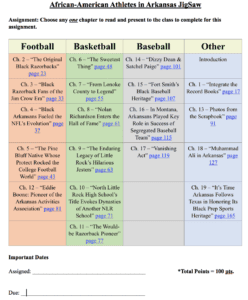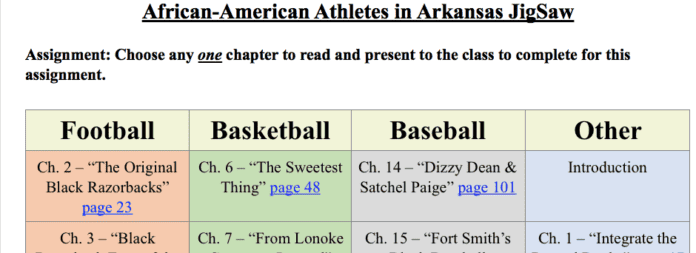Some lesson plans to use with the groundbreaking “African-American Athletes in Arkansas” in your classroom
I’m pleased to announce that Little Rock School District social studies teachers at the high school and middle school levels plan to incorporate lesson plans based off of African-American Athletes in Arkansas starting in January 2018. As an alum of the district (Jefferson, Pulaski Heights, Central), this means a lot to me. It is a significant first step in the public history mission that inspired me to write the anthology—the first of its kind for any state— in the first place.
Educator Dustin Seaton has written four lesson plans for my book. The first of them is available below, with another lesson plan available here. If you need any help with these, or want me to send you the files separately, contact me at info@heritageofsports.com.
LESSON PLAN
Created by Dustin Seaton, GT Specialist, NWA ESC
- Descriptive Data
Teacher: __________________________ Date: _____________________________
Subject Area: _Social Studies/AR History Grade Level: _______7th-12th __________
Unit Title: _AR History/African-American History Lesson Title: Record Keeping vs. Recording History:
Integrate the Record Books
- Standards, Goals, & Objectives (National Middle School Association Standards 1, 2, 3, 4, & 5) Standards (list local, state, or national standards which will be met upon completion of this lesson):
Lesson Goal(s):
- Engage students in jigsaw presentations to read African-American Athletes in Arkansas
- Challenge students to present their chapter in a fun and creative way to share with classmates
Lesson Objective(s): AR History (7/8th Grade)
H.7.AH.7-8.8: Analyze social, economic, and political effects of the Civil Rights Movement on various regions in Arkansas from multiple perspectives (e.g., integration, state legislation)
AR History (9-12th Grade)
Era5.5.AH.9-12.4: Analyze the social, economic, and political effects of the Civil Rights Movement in various regions of Arkansas using primary and secondary sources from multiple perspectives
(e.g., segregation; voting; integration of Fayetteville, Hoxie, and Little Rock School Districts; federal and state legislation)
Era6.6.AH.9-12.4: Analyze ways that Arkansans addressed a variety of public issues by using or challenging local, state, national, and international laws
African-American History (9-12)
IE.6.AAH.2: Examine the various influences of African Americans on social change using primary and secondary sources from multiple perspectives (e.g., migration, feminism, military, social organizations)
JU.7.AAH.2: Identify unresolved social, economic, and political challenges for African American men and women from 1970 to the present using a variety of sources representing multiple perspectives
- Procedure
Grouping for lesson: ____ whole group __X___ small group __X__ individual

Divide the 18 short chapters among individual students. Try giving the longest chapter (“Ali in Arkansas, chapter 18) to a few students. Compare and contrast the summaries of students reading the same chapters independently.
(2_ minutes) SET:
- Today, we are going to read an entire book together as a class, but in pieces. You will each play a role in piecing the entire book together similar to a jigsaw puzzle.
(2-3 class periods) Activity:
- Allow students to review the chapters of the book African-American Athletes in Arkansas by Evin Demirel (see attach chart breaking down the chapters into four categories: Football, Basketball, Baseball, and Other
Students will then choose a chapter to read and present the highlights to the class
based on his/her interest.
- Optional: You can also read the “Introduction” as a class as a set.
- Encourage students to be creative in their presentation of their chapter. Students may choose to present as a handout, PowerPoint, speech, photo-montage, etc. Presentations should be 5-10 minutes maximum.
(10-20 minutes) Closure: Individually, ask students to reflect on their own presentation and how they could improve upon it if they were asked to present it again to another class. Likewise, ask students to write a response on what five facts they learned from other student presentations as well as strategies and/or techniques other student presentations utilized to teach their chapter that was creative and memorable.
- Assessment of Student Learning
Teacher observation, student feedback, & questions & answers from closure activity.
- Modifications for special needs and/or gifted
Student choice in selecting chapters to jigsaw, reading prompt aloud as a class, cooperative learning, open-ended creativity encouraged during presentation format.
- Materials & Equipment Needed
–Book: African-American Athletes in Arkansas: Muhammad Ali’s Tour, Black Razorbacks, & Other Forgotten Stories by Evin Demirel (ISBN: 978-0-9990083-1-7)
- Lesson Extension & Reflection
Ask students to discover ways the book could be jig-sawed together in other ways (i.e. high school, college, and professional breakdowns). Provide bonus points for students who are extra creative in how they present their chapter to the class and/or do additional chapters not covered by a classmate. Students could even be charged with writing a twentieth chapter of another story not included in the book as an extension of this lesson. In other words, researching and writing another chapter of an African-American biography or storyline not already covered in the book.
For a sports-specific extra chapter writing exercise, ask students to think about sports they and their friends play. Are there underrepresented (e.g. not discussed much in media, few videos/stories chronicling the athletes) and/or underfunded athletes or sports today? (Possible responses: hockey (at least in Arkansas), swimming, soccer*, girls sports vs boys [basketball, softball], cheerleading, skateboarding).
Ask “Why do you think this sport is underrepresented?” Write a chapter 20 about one of these sports and some of the socioeconomic and gender/race issues around it.
*Soccer, given its popularity among Latinos, opens up opportunities to discuss socioeconomic/ public history issues as it pertains to the athletic heritage of Hispanics in Arkansas.



